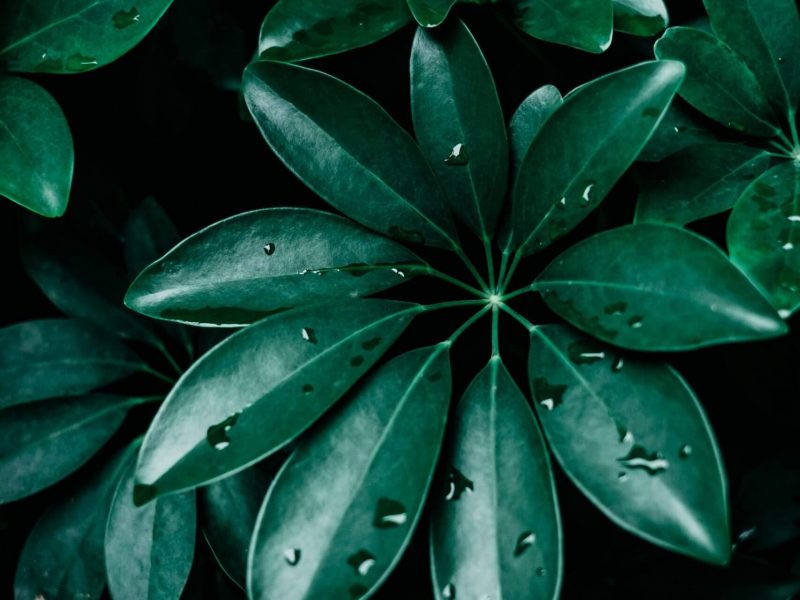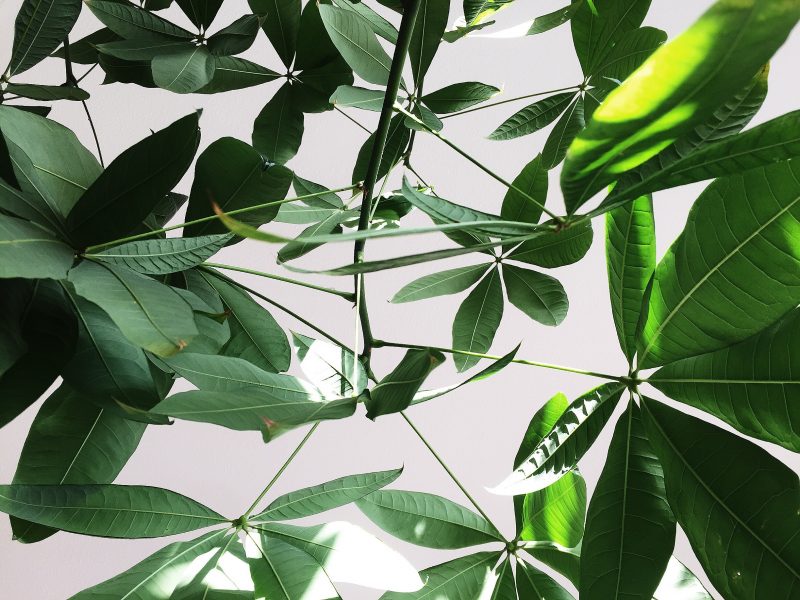
Known for their unique umbrella-like leaves, Schefflera (also commonly known as Umbrella Plants) are becoming more and more popular in the houseplant world. They are quite easy to take care of and don’t require much space in your home compared to some of your other larger houseplants. However, you might find that your Schefflera is starting to show signs of distress in the form of drooping leaves. There are a few reasons why your Schefflera may be drooping, the most common of which are; overwatering, underwatering, insufficient light levels and stress/shock.
Overwatering
Schefflera are pretty hardy plants and won’t die suddenly if you overwater them once in a while. However, consistent overwatering will mean your Schefflera’s leaves will start to droop as their roots begin to rot and turn mushy. Schefflera need to be watered no more than once a week in the hottest months of the year, and less frequently in autumn and winter.
Consistent overwatering will lead to root rot which is very harmful to your Schefflera. It will cause the plant to become unstable, the individual leaves will droop and may even eventually fall off completely as your Schefflera will not be able to get nutrients from the soil to maintain healthy leaves or new growth.
If you think that you may have overwatered your Schefflera it is best to replace the soil straight away rather than just sit and wait for it to dry up over time. Make sure to use a fresh, nutrient rich soil when you do this, our recommendation is this one from Miracle Gro. Be careful when removing the soil from the roots as you don’t want to cause any further damage.
Make sure to check the moisture in the soil before you water your Schefflera. There are two really easy ways to make sure that it definitely needs water. First check the moisture at the top of the soil, if it is still damp then wait a few days before watering again. You can also lift up your Schefflera to check the weight of the plant before and after watering. You will then start to be able to gauge how heavy the soil is when it is in need of water. Make sure to handle your Schefflera gently when picking it up to prevent any leaves from breaking away from the main stem.
If you want to be 100% sure about how much moisture is in the potting mix, and whether it’s actually time to water your Schefflera, then we recommend using a moisture meter. You simply pop them in the soil and it will tell you how soggy the soil is – it’s really that simple. We use this one from Amazon.
Drainage Issues
Sometimes it may not be your watering schedule that is causing your Schefflera’s leaves to droop and fall off, but the poor draining of the soil and pot. You can very easily increase the amount of drainage in your Schefflera by mixing in a small amount of perlite, this will make it far easier for water to flow through and out of the drainage holes of your pots (you should also check to make sure your pots have drainage holes). Another easy step is to add a few small stones or pebbles to the bottom of your pots, this helps in making sure that the drainage holes are never blocked by soil or any loose debris.
Although clay or terracotta pots can be a little bit more expensive or breakable, their upsides are much more than just the aesthetic. The clay they’re made of is permeable which means that some of the water in your soil can evaporate through the sides of the pot. This isn’t the case for the plastic pots that most use, which instead hold in all of that moisture. So sometimes it is worth investing a little more to make sure that the roots of your Schefflera are not sitting in too much moisture. We love using these terracotta pots from Amazon.
Underwatering
Like overwatering, too little water can also be harmful to your Schefflera and cause it to droop (these two often come hand in hand with houseplant problems so it is super important you figure out which one is the cause). Although your Schefflera won’t die on you suddenly if you forget to water it every once in a while, or make it go a little longer without water whilst you are on holiday, consistent underwatering will start to have an impact on your Schefflera’s health (beyond just drooping leaves). If you notice that the drooping leaves are more towards the bottom of the plant, it may be due to underwatering as your plant prioritises new healthy growth over its older leaves.
Stick a finger in the top few centimetres of the soil to check the moisture. You can also try lifting your Schefflera as we mentioned earlier to see it if feels particularly light. If you find that your Schefflera feels very dry, water it a little every other day for a week. Your first instinct might be to give it loads of water straight away but this can actually be harmful to your Schefflera if the soil goes from one extreme to the other (plants get stressed too!). Instead, you want to reintroduce frequent watering for a week or two and this should mean the leaves stop to droop.
If you want the peace of mind of knowing that you’re watering correctly, consider investing in a moisture meter and a self-watering pot like this one. These affordable little gadgets will make caring for your plants just so much easier!
Insufficient light levels
Schefflera plants like bright, indirect light and if they spend too long in a shady spot, their lower leaves may start to droop and then drop off one by one. Make sure you place them in a spot that receives several hours of bright light each day. But make sure they aren’t placed directly next to a window, as direct light will cause other issues for your Schefflera, so it is about finding the right balance.
You might also need to think about moving your Schefflera around depending on the seasons. In the winter months, when the sun isn’t as strong (and out for less of the day) it might be necessary to move your plant a little closer to the window to make use of the limited sunlight as best as possible. It’s best to use a light meter to measure the amount of light your plant gets throughout the day/year as it might be getting a lot more or less than you think!
If you’re really running low on light (like we all do in winter!) you could consider getting yourself an LED light like this one, these help massively in supplementing light and keeping your plants thriving through the darker months.
Stress and shock
Just like humans, Schefflera plants can get a little stressed out when they move home. In their case moving home can be as simple as moving to a new, bigger pot. Signs such as drooping leaves after repotting your Schefflera are totally normal. It may take a few days for the signs to appear but in the right environment, with the right care, it should only take a few weeks for your Schefflera to get used to the new pot and get back to normal. Keep an eye on your Schefflera after repotting to make sure that the signs do not continue for too long.
Your Schefflera may also show signs of stress and drooping leaves if it has been moved to a new spot in your home. A sudden change in light conditions or temperature cause your Schefflera to go into shock. If your plant is still receiving enough light, and the temperature change is not too extreme, then it should settle into its new home nicely after a few weeks. Use a digital thermometer to check your plant isn’t being exposed to extreme drafts or hotspots. If you have moved home, the bumps it may have encountered in the process might have also caused a few leaves to drop but it shouldn’t be anything to worry about long term.
Be careful about placing your plant near any ac/heating vents or radiators. The drafts or heat pockets that are created will also cause your Schefflera to display signs of stress, drooping leaves being one of these signs.
If your Schefflera’s leaves are drooping, but none (or very few) have fallen off, then you’re in luck as you should have caught the issue quick enough to be able to reverse it pretty easily. Once you have diagnosed the issue and rectified the environment or care, your Schefflera should stop drooping and return to full health after a few weeks. If your plant has lost a lot of leaves and you have only just noticed, don’t worry as with the right care, there is no reason why your plant can’t bounce back. It may just take a little longer and require a closer eye. It might be a good idea to take some cuttings from your Schefflera to propagate it to save some of the healthy parts.














